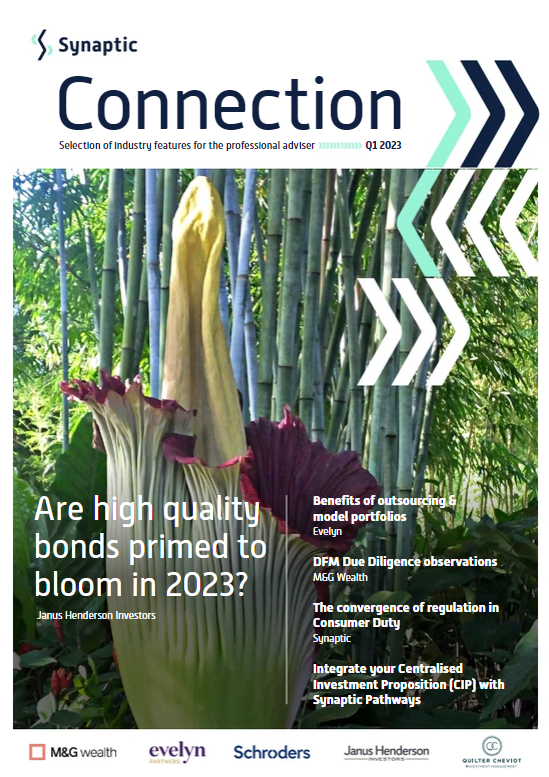In this edition...
- What we know – and what we don’t Patrick Farrell, Chief Investment Officer and Head of Research - Charles Stanley
- Regime shift: five seismic adjustments taking place in the global economy Azad Zangana, Senior European Economist and Strategist - Schroders
- How to navigate a recession Mike Coop, Morningstar Investment Management - EMEA
- High quality bonds are primed to bloom in 2023 John Pattullo, Co-Head of Global Bonds- Janus Henderson
- Fixed Income - Research Matters Andrew Metcalf, Fixed Income Portfolio Manager - Close Brothers Asset Management
- From 'TINA to 'TANIA'... Bryn Jones, Head of Fixed Income - Rathbones
- The RSMR Broadcast: How impactful is investment management outsourcing? Scott McNiven, MPS Accounts Manager - RSMR
- Hours to minutes Synaptic,
- Benefits of outsourcing and model portfolios Evelyn & Partners,
- DFM Due Diligence – some observations Sean Hawkins, Head of Business Development - M&G Wealth Investments
- 2022 – The death knell for the 60/40 approach to investing? John Husselbee, Head of Multi-Asset - Liontrust
- Why ‘nature positive’ will be as big as net zero Jenn-Hui Tan, Global Head of Stewardship & Sustainable Investing - Fidelity International
- The rise of the female investor Vanessa Eve, Investment Manager - Quilter Cheviot
- Integrate your Centralised Investment Proposition (CIP) with Synaptic Pathways Eric Armstrong, Client Director - Synaptic
- The convergence of regulation in Consumer Duty Eric Armstrong, Client Director, Synaptic
- Tackle Consumer Duty with the new Synaptic integration Alan Lakey , Director - CIExpert & Highclere Financial Services Ltd
 Rathbones head of fixed income Bryn Jones explains why even the most tenacious equity bulls are starting to acknowledge that the era of ‘there is no alternative’ to stocks is finally done.
Rathbones head of fixed income Bryn Jones explains why even the most tenacious equity bulls are starting to acknowledge that the era of ‘there is no alternative’ to stocks is finally done.
For years and years, I’ve had to listen to the acronym ‘TINA’ being bandied about. Equity bulls used it as shorthand to promote their view that stocks were the only viable investment option once central banks slashed interest rates and launched huge bond-buying programmes in the wake of the Global Financial Crisis. This emergency policy drove the income yields on many bonds so low that, according to the TINA (‘there is no alternative’) crowd, they were hardly worth bothering with.
These arguments grew louder as more and more bonds began to sport negative yields. Bond yields and prices run in opposite directions so many bonds’ yields dipped below zero as their prices climbed, guaranteeing that any investors holding them to maturity would lose money. By late 2020, the market value of bonds trading with negative yields had reached an eye-watering £14.8 trillion. Gulp!
Hardly surprisingly, my team and I never had any truck with the TINA mantra even when so many bonds sported negative yields. We were adamant that we wouldn’t pile into bonds that could only deliver decent returns if their high prices got higher still. (In the bond world, income returns are fixed, so the only way you can make more money from buying a bond for more than its face value is if someone else pays more for the bond in the future.) It was certainly tough going at times, but we always managed to find bonds that we felt offered decent yields without overloading on risk.
An awful lot has changed in the last year. The advent of sticky and high inflation has forced central banks to call time on ultra-loose monetary policy. As they’ve hiked rates aggressively and ended their bond-buying programmes, this has driven a huge reset in bond yields and prices.
Higher rates and high inflation eat into bonds’ fixed returns so their prices fell very steeply last year, while their yields have been on a tear, making their biggest annual gains in decades. For example, 10-year US Treasury yields have almost doubled in the past year to around 3.5%, while the 10-year Gilt yield is hovering around 3.3% compared with 1.1% a year ago. And the yield on 10-year German Bunds is up from below zero to around 2.2%.
Earlier this month it was announced that this reset means that sub-zero-yielding debt has basically disappeared. A Bloomberg index that tracks the world’s stock of negative-yielding bonds fell to zero for the first time since 2010.
"Higher rates and high inflation eat into bonds’ fixed returns so their prices fell very steeply last year, while their yields have been on a tear, making their biggest annual gains in decades."
A “sea change” in fixed income?
As government bond yields have soared, credit spreads – the extra yield (or spread) that corporate debt offers relative to government bonds for taking on default risks – have blown out. At the start of last year, the iTraxx European Crossover Index, which measures this spread, stood at 242 basis points (bps). It’s now around 420bps. Investors are being much better rewarded for bearing credit risk than they have for many years.
Broad indices of sterling investment grade credit now yield well over 5%, compared with just over 2% at the start of 2022 and 3.4% on average since 2010. This means corporate bonds at the higher end of the credit quality spectrum can now offer investors a way to achieve their long-term return objectives through income alone. And, of course, now that corporate bond yields are much juicier, they provide a more solid buffer against any potential price volatility.
This is a big shift. Celebrated investor Howard Marks, who founded Oaktree Capital Management, is calling it a “sea change”. He thinks that credit’s potential to deliver “solid returns” means that investors no longer need to rely as much on “riskier instruments”, in other words, equities, to achieve their “overall return targets.”
Hurrah! It seems like more and more investors are now prepared to look beyond stocks and find that in fact ‘there are now investment alternatives’. We’ve shifted from TINA to TANIA…
Fund Manager – Bryn Jones
Bryn has managed the Rathbone Ethical Bond Fund for 18 years. He is the Head of Fixed Income for Rathbones, and apart from this fund is lead manager on the Rathbone Strategic Bond Fund and manager of institutional mandates. He joined Rathbones in November 2004 from Merrill Lynch, where he managed $2 billion of fixed income assets. He is a WMA representative for the HMT DMO’s (Her Majesty’s Treasury - Debt Management Office) gilt market consultation process. He has been a guest speaker at the Euromoney Bond Conference in London, and at the Euromoney Bank Capital Conference in Amsterdam. Bryn regularly appears on CNBC, CNBC Arabia and Bloomberg TV. About Rathbone Funds
About Rathbone Funds
Rathbone Unit Trust Management (Rathbone Funds) is a leading UK fund manager. An active management house, offering equity and bond unit trusts and multi-asset portfolios to meet your capital growth and income requirements.
Rathbone Unit Trust Management Limited is a wholly-owned, London-based subsidiary of Rathbones Group Plc. Through its subsidiaries, Rathbones Group Plc manages £60.2 billion of client funds, of which £11.0 billion is managed by Rathbone Unit Trust Management Limited*
*Funds under management at 31 December 2022.
Get in touch
rathbonefunds.com
020 7399 0399
rutm@rathbones.com
LinkedIn: Rathbonesprofessionaladvisers
Sign up for updates
Keep up to speed with everything you need to know each quarter, by email or post.


